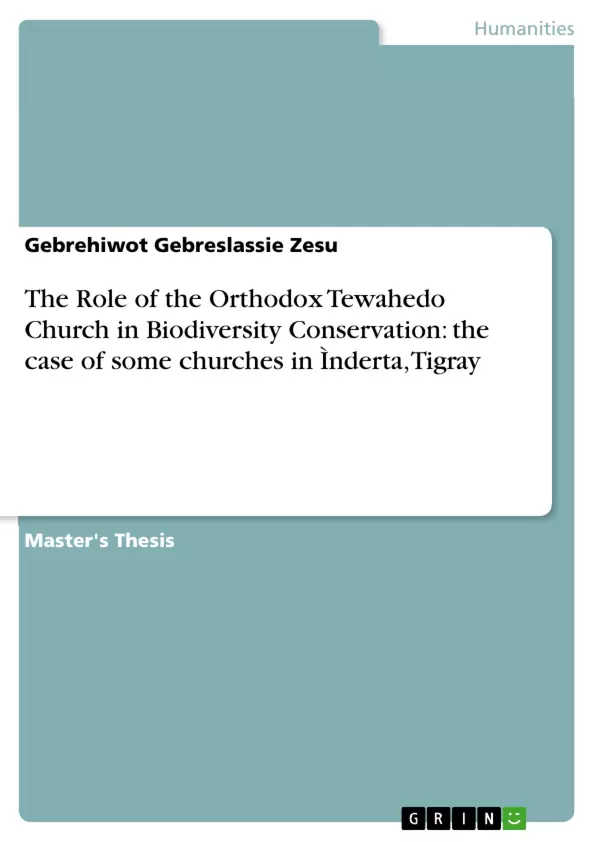The Ethiopian Orthodox Tewahedo Church, which is believed to be the largest of the five non-Chalcedonian Eastern Churches and is believed as playing an important role in Ethiopian life is a unique church deeply based upon Ethiopian history, social life and ethics. In addition to its religious services, i has a long tradition of conserving biodiversity. Hence, if a traveler sees a patch of indigenous big trees in the northern highlands of Ethiopia, most probably there is an Orthodox Tewahedo Church in the center.
Having the main objective of investigating the role of the Orthodox Tewahedo Church in biodiversity conservation, the paper deals with the religious values (principles and actions) of the EOTC that are in favor of biodiversity conservation. In line with, it tries to explore the church values in relation to biodiversity conservation in terms of the sacred and profane (space wise dichotomy). Moreover,identify the cultural bases on what plants and animals are conserved in the Church compounds.
For this purpose, four churches were purposely selected from Ìnderta wereda. To encounter informants in their everyday life, the researcher lived for five months in the churches especially, in churches of Mika‘el Tsellamo and Mika‘el Romanat and use ‘Participant observation’. Moreover, the researcher used semi-structured and informal interviews. To this end, semi-structured interview was conducted with 40 purposely selected respondents. Accordingly, 30 respondents from Mika‘el Romanat and Mika‘el Tsellamo (15 from each) and 10 respondents from Khokholo Yowhannis and Mika‘el Dagya churches (5 from each) were interviewed. Moreover, in-depth interview was hold with key informants from the churches. Besides, different secondary sources were employed.
The Church is playing a prominent role in conserving the biological diversity. Results indicated that it is due to the sacredness of the Church area that the plants and animals are well-conserved in the churches. It was found that the community respect and conserve natural Church plants and animals with no discrimination regardless of their benefits to the Church and the communities. In general, from the results, it was concluded that the sacredness of the Ethiopian Orthodox Tewahedo Church area have a prominent role for sustainable biodiversity conservation. Thus, the Ethiopian Orthodox Tewahedo believers are Anthropocentrists outside the church compounds and Deep ecologists within the church compound.
Inhaltsverzeichnis (Table of Contents)
- CHAPTER ONE, INTRODUCTION
- Back ground of the study
- Problem statement and justification
- Research questions
- Objectives of the research
- General objective
- Specific objectives
- Significance of the study
- CHAPTER TWO, LITERATURE REVIEW
- Conceptual and Theoretical framework
- Conceptual framework
- Ethiopian Orthodox Tewahedo Church
- The Sacred and the Profane
- Biodiversity and Culture
- Theoretical Framework
- Economic and Institutional theorists view
- Cultural theorists view
- Christian Anthropocentrism (human-centered ethics)
- Christian Deep ecology (Creation-centered ethics)
- Review of Related Literature
- Biodiversity and Culture
- Biodiversity and sacred areas in the World and Ethiopia
- CHAPTER THREE, RESEARCH DESIGN AND METHODOLOGY
- Description of the Study area
- The study site: Churches selected for the study
- Mika'el Tsellamo Church
- Mika'el Romanat Church
- Khokholo Yowhannis
- Mika'el Dagia Church
- Research Methodology and Methods of Data collection
- CHAPTER FOUR, FINDINGS AND ANALYSIS
- Biodiversity: Plants and Animals in Orthodox Tewahedo Churches
- The Churches and their Plant composition
- The Churches and their animal composition
- Community's view towards Plants and Animals in the Church
- Community's view on the Church Plants
- Community's view on Animals in the Church
- Significance of Church Plants
- The Sacred and Profane dichotomy in the Churches
Zielsetzung und Themenschwerpunkte (Objectives and Key Themes)
This paper explores the role of the Ethiopian Orthodox Tewahedo Church (EOTC) in biodiversity conservation. The main objectives are to identify the EOTC's religious values that promote biodiversity conservation, to explore the EOTC's values in relation to the sacred and profane, and to examine the cultural basis for plant and animal conservation within church compounds. The study aims to understand the role of the EOTC in biodiversity conservation by investigating the local community's perspectives and practices.
- The role of religious values in biodiversity conservation.
- The relationship between the sacred and the profane in the context of biodiversity conservation.
- The cultural basis for plant and animal conservation within church compounds.
- The influence of the EOTC on local community perceptions of biodiversity.
- The role of the EOTC in sustainable biodiversity conservation.
Zusammenfassung der Kapitel (Chapter Summaries)
Chapter one introduces the background of the study, outlining the significance of the EOTC in Ethiopian life and its role in conserving biodiversity. It also defines the problem statement, research questions, and objectives. Chapter two reviews the literature on biodiversity and culture, exploring concepts such as the sacred and the profane, anthropocentrism, and deep ecology. It also examines related research on biodiversity conservation in sacred areas worldwide. Chapter three details the research design and methodology used in the study. It includes information on the study area, the selected churches, and the data collection methods employed. Chapter four presents the findings and analysis, examining the biodiversity within the church compounds, the community's views on plant and animal conservation, and the significance of church plants. It also discusses the sacred and profane dichotomy in the churches.
Schlüsselwörter (Keywords)
Ethiopian Orthodox Tewahedo Church, biodiversity conservation, religious values, sacred and profane, anthropocentrism, deep ecology, cultural practices, community perceptions, sustainable conservation.
- Arbeit zitieren
- Gebrehiwot Gebreslassie Zesu (Autor:in), 2012, The Role of the Orthodox Tewahedo Church in Biodiversity Conservation: the case of some churches in Ìnderta, Tigray, München, GRIN Verlag, https://www.grin.com/document/204083



